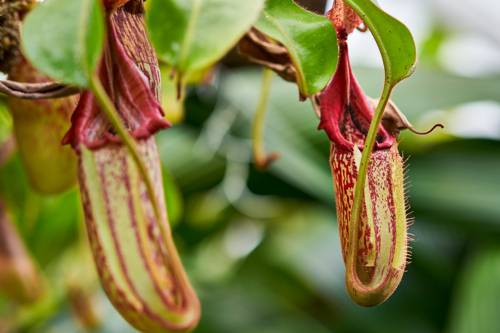
FAQ About Indoor Plant Vining Techniques

What are indoor vining plants?
Indoor vining plants are species of plants that have long, trailing stems that can climb or cascade, making them perfect for indoor gardening. They are known for their ability to adapt to various living conditions and can be trained to grow on structures like trellises, moss poles, or simply hang down from pots. Popular indoor vining plants include pothos, philodendrons, and ivy.

How do I choose the right trellis design for my indoor vining plants?
When choosing a trellis design for indoor vining plants, consider the growth habit of the plant, available space, and aesthetic preferences. A simple wire frame or a wooden trellis can support lighter vines like pothos or ivy. For heavier vines, a more robust structure like a moss pole might be necessary. Ensure the trellis complements the plant's natural growth pattern and fits comfortably within your space.

Why is pruning important for indoor vining plants?
Pruning is essential for indoor vining plants as it encourages healthy growth, controls the plant size, and promotes bushier foliage. Regular pruning helps remove dead or diseased leaves and stems, improving overall plant health and appearance. It also stimulates new growth, allowing the plant to develop more lush and vibrant foliage.

What is the best time to prune indoor vining plants?
The best time to prune indoor vining plants is during their active growing season, typically in the spring and summer months. This is when plants are most vigorous and can quickly recover from pruning. Avoid heavy pruning during the dormant periods in fall and winter, as this can stress the plant.

How often should I water my indoor vining plants?
The watering frequency for indoor vining plants depends on the species, pot size, and environmental conditions like humidity and temperature. Generally, water when the top inch of soil feels dry to the touch. Ensure adequate drainage to prevent root rot, and reduce watering in the winter months when plant growth slows.

What are some common challenges faced with indoor vining plants?
Common challenges with indoor vining plants include pests such as spider mites and aphids, overwatering, insufficient light, and nutrient deficiencies. To manage these challenges, regularly inspect your plants for pests, ensure proper drainage, provide adequate light (many vining plants prefer bright, indirect light), and fertilize appropriately during the growing season.

Can I propagate my indoor vining plants, and how?
Yes, many indoor vining plants can be propagated easily, typically through stem cuttings. Cut a section of the vine just below a node, remove the bottom leaves, and place the cutting in water or moist soil. Roots should develop within a few weeks, after which the cutting can be potted into soil. Ensure the cuttings have good indirect light to promote growth.

How do I support and train indoor vining plants to grow on a trellis?
To support and train indoor vining plants on a trellis, gently guide the vines towards the trellis and secure them loosely with plant ties or soft string. Do not tie too tightly as this can damage the stem. Regularly check the plant's progress and adjust the ties as needed to encourage the vine to climb. Prune as necessary to encourage bushiness and prevent tangling.

What is a moss pole, and how is it used with indoor vining plants?
A moss pole is a support structure made of moss that is wrapped around a pole or stake, providing a natural surface for vining plants to cling to. To use a moss pole, insert it into the plant pot, and gently secure the plant's vines to it with plant ties. The moss can absorb moisture, which supports the plant's aerial roots, promoting healthier growth and more robust climbing behavior.

How can I ensure my indoor vining plant receives enough light?
To ensure your indoor vining plant receives enough light, place it near a bright, east or north-facing window, but out of direct sunlight to avoid leaf burn. For low-light areas, consider using grow lights, which can supplement natural lighting. Monitor the plant's growth and leaf color as indicators of sufficient light, adjusting the plant's position or lighting as needed.

Can indoor vining plants purify the air?
Yes, some indoor vining plants are known for their air-purifying qualities. Plants like pothos and philodendrons have been shown to remove common indoor pollutants such as formaldehyde, benzene, and xylene from the air. Having these plants in your home can help improve air quality and create a healthier indoor environment.

How can I prevent my indoor vining plant from becoming too leggy?
To prevent indoor vining plants from becoming too leggy, ensure they receive adequate light and prune regularly to encourage bushier growth. Legginess is often a result of insufficient light, causing the plant to stretch towards the light source. Rotating the plant periodically can help it grow more evenly. Fertilizing during the growing season can also promote healthy leaf production.

What type of soil is best for indoor vining plants?
Indoor vining plants generally thrive in well-draining, loose soil mixtures. A combination of potting soil, perlite, and peat moss can provide the right balance of drainage and moisture retention. This type of soil prevents waterlogging and allows for adequate air circulation around the roots, reducing the risk of root rot.

Do indoor vining plants need fertilizers?
Yes, indoor vining plants can benefit from regular fertilization during their active growing season, which is usually spring through summer. Use a balanced liquid fertilizer every 4-6 weeks to provide essential nutrients that support healthy growth and vibrant foliage. Reduce or stop fertilizing during the plant's dormant period in fall and winter.

How can I control pests on my indoor vining plants?
To control pests on indoor vining plants, begin by regularly inspecting your plants for signs of infestation. Remove any visible pests by hand or with a damp cloth. Use insecticidal soap or neem oil as a non-toxic method to manage pest populations. Ensure healthy plant conditions by providing proper light, water, and nutrients to prevent stress that can make plants more susceptible to pests.

What are some popular indoor vining plants?
Popular indoor vining plants include pothos, philodendrons, English ivy, string of hearts, and hoyas. Each of these plants is well-suited for indoor environments and offers unique foliage patterns and textures. They are typically easy to care for and grow, making them perfect for both beginner and experienced plant enthusiasts.

How do I propagate pothos plants?
Pothos can be easily propagated through stem cuttings. Cut a vine section just below a node, remove the lower leaves, and place the cutting in water or moist potting mix. Keep the cutting in indirect light, and roots should form within a few weeks. Once roots are established, transplant the cutting into a pot with soil.

What are the signs of overwatering in indoor vining plants?
Signs of overwatering in indoor vining plants include yellowing leaves, wilting, and a musty smell from the soil. The soil may also feel constantly wet, and there might be visible root rot. To prevent overwatering, ensure pots have adequate drainage, and water only when the top inch of soil feels dry. Adjust watering frequency based on environmental conditions and plant size.

Why are my indoor vining plant leaves turning yellow?
Yellowing leaves on indoor vining plants can be caused by several factors, including overwatering, underwatering, lack of nutrients, or insufficient light. Evaluate the plant’s watering schedule, ensure it's not in a dark area, and consider adding a balanced fertilizer if nutrient deficiency is suspected. Regularly inspecting soil moisture and lighting can help prevent leaf yellowing.

How can I make my indoor vining plant bushier?
To make indoor vining plants bushier, practice regular pruning by cutting back stems to just above a node, which encourages new stems to grow. Providing sufficient light and regular feeding during the growing season can also promote bushier growth. Rotating the plant periodically ensures even exposure to light, preventing uneven or sparse growth.
